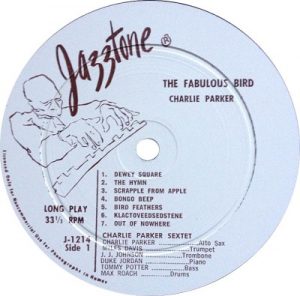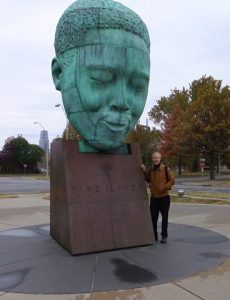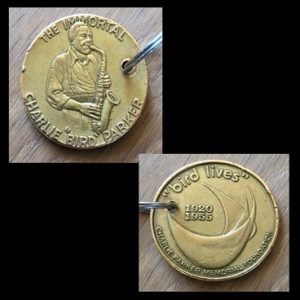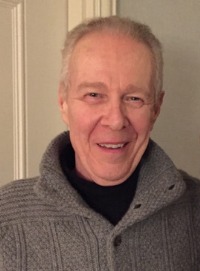
Bird Lives
by
Robert Hecht
The night I truly ‘got’ the shining genius of Charlie Parker I was in my girlfriend’s apartment on the Lower East Side. The year was 1961. I was nineteen, she was much older and hipper, and had turned me on not only to some great music but to getting high as well. She had all the essential jazz records, including the one on the turntable that night. It was The Fabulous Bird, on the old Jazztone label, consisting of reissues of some of Bird’s phenomenal 1947 Dial sessions. She had a very low-fi stereo—I can still see the nickel she had scotch-taped to the tone arm to keep it in the grooves. But the fidelity didn’t matter, in part at least because this evening I had just smoked a skinny ‘New York Tube’ stick of tea.
Though I had been a jazz lover since the age of ten and had been listening to Bird for several years—and certainly recognized his importance—I had never fully ‘heard’ him. I guess he just had never totally broken through for me. But that evening, when he played “Out of Nowhere,” everything changed. In the master take of that great old Johnny Green composition, Bird develops a breathtakingly beautiful motif, with a series of repeating figures that simply knocked me out and still does to this day as I write this in 2017. His complete mastery came through so clearly and profoundly—the incredible melodic invention, the perfect musical architecture of his solo, the rock-solid sense of time and swing, the deep, deep soulfulness of his playing, the sound, both smooth and raw at the same time, and the virtuosity—my god the virtuosity! I was transfixed…I was hooked. Again and again I lifted that nickel-taped arm back to the beginning of that track to soak in the marvels of his playing.
From that night on, Bird was the end for me, and still is, lo these many decades later. After his death, jazz fans famously scrawled ‘Bird Lives’ on the walls of subways and buildings in New York and in other jazz-crazy cities. (I once did so myself in some wet sidewalk cement in Palo Alto, California.) In truth, his music lives on as a towering achievement — some might even say the towering achievement of twentieth century music.
But cut to another night eighteen years later — this time in Kansas City — a hot and very humid night in late August. KC was Bird’s hometown, the place where he apprenticed and became a master himself.
Late that night I stood waiting in the dark outside the entrance to the old Musicians Union Hall, Local 627, a Kansas City music landmark. “Whatchoo wanna go there for?” our ancient black cab driver had asked. “Ain’t nothin’ but a bunch a crazy dope fiends ‘round there.”
But there was history here. Local 627 was one of the earliest and most important African-American musicians unions. This was where Prez first met the Count, where young Bird had jammed, where so many greats had stopped on their way through KC. The Union Hall was an old brick building, and even in the dark I could make out large pink music notes painted on its exterior. We’d heard there were still occasional all-night jam sessions in this old shrine, and we were desperate to find some real jazz during our short visit to the city…and hoping they would let in a couple of “ofays” from California. But my sharp knocks were getting no response and I was feeling as if I might be swallowed up by the Kansas City night.
This was the heart of the KC slum neighborhood, and the truth was, I was feeling very small and very white standing there in the pitch dark.
A sliver of light slipped through a crack in the door and I imagined a private party going on inside, with no one admitted without the right password or secret knock. I thought for a second I heard a laugh and imagined I caught a whiff of weed (just wishful sniffing I guess), but no one answered, and after a while I gave up knocking and walked back to our waiting taxi.
“No luck,” I said to my friend Michael as I slid into the back seat. “I guess we were not meant to hear real Kansas City jazz on this trip.” Earlier in the evening we had scoured the city for good jazz, and after having suffered through some overly-slick cocktail piano had given up and faced the ironic reality that on this night in this former jazz mecca there was nothing good to hear. That was when we had thought to look up the old Union Hall. And now that was a bust as well.
We were in KC for a business conference but in our off hours we were trying to catch something of the real essence of the place and its rich jazz history. (This was many years before the creation of the wonderful American Jazz Museum there, and before the remarkable statue of Bird was erected.)
Our cab driver then salvaged the night by giving us a tour of the area between 12th Street (as in Basie’s 12 Street Rag) and 18th Street. This was the neighborhood where, at the peak of KC’s corruption-nurtured jazz era, there had been a substantial number of jazz and blues clubs. Our cabbie knew where many of the old clubs and ballrooms had been located, even though there were no visible traces of them now.
He pointed to a corner vacant lot at 18th and Highland. “Right there’s where the Sunset Club used to be.” Thick weeds were overgrowing the mere rubble of old walls, walls that had once absorbed the sounds of classic jam sessions. Lester Young, Ben Webster, Herschel Evans, Coleman Hawkins and Charlie Parker had played chorus after chorus well into the morning hours here. During its heyday Kansas City was famous for some of the most legendary, and longest, sessions in jazz history.
He drove on and we passed the junction of 18th and Vine where nothing stands now but a street sign and the memory of Big Joe Turner singing his Piney Brown Blues.
Yes I dreamed last night I was standing at the corner of 18th and Vine,
I shook hands with Piney Brown and I could hardly keep from cryin’.
Then we were over on 12th Street again, staring through the dark at an empty space where the Reno Club had once stood. This, as the legend goes, was where the young Bird, not yet together musically, was ridiculed for his faltering attempts at playing and forced to leave the club, and the city, in humiliation. He told his friend Gene Ramey, “Don’t worry, I’ll be back. I’ll fix these cats. Everybody’s laughing at me now, but just wait and see.” After some serious woodshedding, Bird did indeed fix those cats, and all the cats on all the instruments in jazz, revolutionizing the entire art form.
So ended our late night exploration of that historic area. But the next morning, because we were determined to find some trace of our musical idol, we decided to escape entirely from the business conference and instead to continue exploring the city and somehow pay homage to Bird. Searching the phone book (this was way before the Internet — remember phone books?), I came across a listing for the Charlie Parker Memorial Foundation. I called and learned it was an academy of the arts for kids from the ghetto; the person I spoke with said we were welcome to pay a visit, and we decided to walk across town to check it out. The walk would also give us an opportunity to see more of Bird’s old neighborhood.
Picture, then, the unlikely sight of two white jazz freaks in their thirties strolling through Kansas City’s black neighborhood on a sunny summer day, occasionally even having the audacity to whistle or sing Charlie Parker solos — solos that had been studiously memorized over years of devout listening. I remember singing random fragments of the famous King Pleasure lyric to Bird’s great blues, “Parker’s Mood.”
Come with me,
if you want to go to Kansas City.
I’m feeling low down and blue, my heart’s full of sorrow
Don’t hardly know what to do; where will I be tomorrow?
Goin’ to Kansas City. Want to go, too?
We passed by Olive Street but couldn’t locate Bird’s childhood home there among the mostly ramshackle houses in the neighborhood. After several miles of walking we found our way to the Foundation, a professional-looking one-story building. We went in and introduced ourselves as Bird fans who had come simply because of our love and respect for the greatness of the man and his art.
We were not at all prepared for the reception we received. Several of the staff and faculty took time out of their morning to chat with us and to explain what was going on at the Foundation. They seemed genuinely pleased, tickled that we had gone out of our way to visit.
The Foundation’s slogan was ‘Off the streets and into the arts.’ Its mission was to provide African-American youth with instruction in music, both jazz and classical, as well as drama, dance and other performing arts, and had been established several years before by KC musician Eddie Baker. Numerous jazz masters, including Clark Terry and Max Roach, had donated their time to conduct clinics for the neighborhood kids.
We were introduced to Anne Brown, the Dean of the Foundation, who also welcomed us warmly. On the wall in her office was a black and white photo taken at the time of Bird’s burial in Kansas City back in ‘55. In the picture, Max Roach and other jazz greats stood at the gravesite. I asked where the grave was, so that we might pay our respects.
“You’ll never find it,” said Dean Brown. “People chipped away at the gravestone to take away some souvenir of the great Bird. Now there’s nothing left.” (I’ve since read that many years later a new headstone was installed but with the egregious error of being decorated with an engraved tenor sax, not the alto Bird primarily played.)
After showing us around the classrooms and performance spaces, Jim, one of the Foundation’s music teachers, drove us to Arthur Bryant’s for lunch, arguably KC’s premier barbecue joint. Afterwards, on the way back to the Foundation, he showed us the city’s only ‘monument’ to Bird at that time — a housing project called Charlie Parker Square. Although the project had street names such as Mary Lou Williams Way, Bennie Moten Lane and Ella Fitzgerald Drive, our new friend had a cynical view of it all. “I’ll bet that only one or two people living there even know who Bird was, let alone listen to his music,” he said with more than a little disgust. “They’re all into disco!”
Jim drove us back to the Foundation where before taking our leave we wanted to say goodbye to Dean Brown. We sat and chatted with her for a bit more in her office, telling her how impressed we were by the work they were doing there, as well as by their graciousness and warmth about our spontaneous visit. With that, to our utter astonishment, she took from her desk drawer two bronze medallions and handed them to us. Engraved on one side was a beautiful likeness of Parker playing his horn, surrounded by the words, ‘The Immortal Charlie “Bird” Parker,’ and on the reverse side the dates of his too-short life (1920-1955), the name of the Foundation, and the encomium ‘Bird Lives.’
“We normally reserve these for our contributing members,” she said. “But this is a very special day, and we’ve been touched that you came by today.”
Amazed by her generosity, and knowing this was something we would treasure for the rest of our lives, we thanked her profusely and I asked, “What did you mean this is a special day?”
She smiled broadly and said, “You didn’t know? Today is August 29th. It’s Charlie Parker’s birthday!”
_____
Postscript:
It would be decades before I was to return to Kansas City, by which time the American Jazz Museum had been created in the 18th & Vine district, and where the powerful sculpture of Bird stands in a plaza near the museum. Beneath the huge bronze bust are inscribed the words ‘Bird Lives.’ My wife photographed me there next to Bird in 2011.

And here is a photo of the bronze medallion I was given all those years ago, which stays close with me every day on my key chain.

_____

Robert Hecht is an award-winning jazz disc jockey and fine art photographer whose photo work has been published in LensWork, Black & White, Zyzzyva and The Sun and exhibited internationally. His writing has previously appeared in LensWork and in the haiku journals Frogpond, Bottle Rockets and Modern Haiku. He and his wife live in Portland, Oregon. For twenty-five years they have been partners in On Point Productions, writing and producing marketing and training video programs. Visit his website by clicking here.
“Out of Nowhere”
King Pleasure sings “Parker’s Mood”
Big Joe Turner sings “Piney Brown Blues”
Click here to read the Jerry Jazz Musician interview with Chuck Haddix, author of Kansas City Jazz: From Ragtime to Bebop
Click here to visit the photo exhibit associated with Kansas City Jazz: From Ragtime to Bebop





























What a wonderful remembrance … thank-you for sending it …